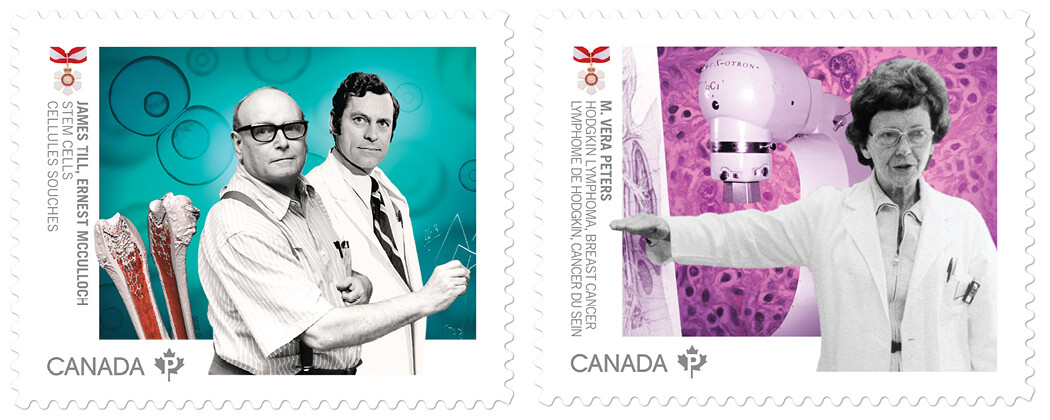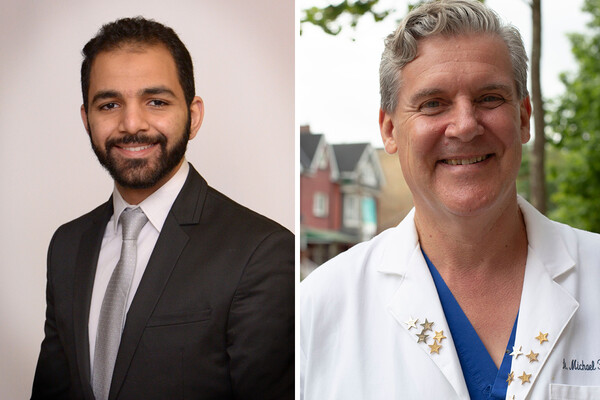Breadcrumbs
- Home
- MD/PhD Program
- News
- Three U of T Researchers Celebrated on Canadian Stamps
Three U of T Researchers Celebrated on Canadian Stamps

Three eminent University of Toronto researchers and physicians are being celebrated today as part of a launch of a commemorative stamp series by Canada Post.
Drs. M. Vera Peters, Ernest McCulloch and James Till are among six Canadian researchers and physicians being recognized in the “Medical Groundbreakers” issue from the Crown Corporation.
The late Peters was a Faculty of Medicine graduate who was one of the faculty’s first female professors.
Till is a professor emeritus in the Department of Medical Biophysics at University of Toronto’s Faculty of Medicine, and the late McCulloch was a professor emeritus at the University of Toronto’s Department of Medical Biophysics.
The other stamps recognize Drs. Bruce Chown, Julio Montaner and Balfour Mount.
The group made groundbreaking contributions in the fields of pediatric pathology, HIV/AIDS, palliative care, oncology and stem cell science.
The Medical Groundbreakers stamp issue was proposed to Canada Post by Dr. Jean Wang, an associate professor in the Department of Medicine, who is also a Princess Margaret Clinician Scientist and a member of the Canada Post Stamp Advisory Committee.
The committee, which includes artists, historians and philatelists who collect and study stamps, consider stamp topic suggestions and designs, and recommend an annual stamp program to Canada Post.
That yearly program consists of about 20 broad subjects or themes covering about 40 to 50 individual stamps.
The Medical Groundbreakers stamps have been in development for two years.
“All of these physicians and researchers changed the face of healthcare in Canada and globally,” says Dr. Wang. “Along with the beautiful stamp designs, we want to share with Canadians the stories behind these remarkable individuals and their achievements. This is Canada’s history.”
Till and McCulloch, considered the fathers of stem cell science, founded a whole new field of research by demonstrating the existence of stem cells in the bone marrow – cells that can self-renew and make different kinds of blood cells.
Their work, begun at the Ontario Cancer Institute (now Princess Margaret Cancer Centre), laid the foundation for stem cell science and propelled Canada into the forefront of this new field, where it remains today.
Stem cell science has also changed the course of cancer research, and paved the way for regenerative medicine, which aims to develop ways to repair or replace diseased cells, tissues or organs.
The partnership of Till and McCulloch was based on strong collaboration, a deep, respectful friendship and a balance between Till’s meticulous, physics-based style of science and McCulloch’s big-picture style of thinking about cell biology.
“Reading their original papers shows how elegantly they designed their experiments without the benefit of today’s technology,” marvels Wang.
“Their work shows how to approach a problem, how to design an experiment. It is a master class in the scientific method that still stands the test of time.”
Currently, bone marrow transplantation is used to treat blood cancers such as leukemia, myeloma and lymphoma by transplanting healthy stem cells to restore a patient’s ability to create healthy blood cells.
Promising stem cell clinical trials are underway in diabetes, heart disease, macular degeneration, multiple sclerosis, and Parkinson’s disease.
Till and McCulloch have been the recipients of numerous awards, including the coveted Gairdner Foundation International Award and the Albert Lasker Basic Medical Research Award – considered the most prestigious medical science award in the United States.
Both were inducted into the Canadian Medical Hall of Fame and invested into the Order of Canada. McCulloch passed away in 2011.
Bold and unwavering, Peters revolutionized the way we approach cancer treatment and was a champion of patient-centred care.
She was a clinician and scientist, and rose to prominence in an era when women were not well respected as scientists.
In 1934, Peters was one of 10 women in a class of 115 to graduate from University of Toronto’s Faculty of Medicine.
In 1937, she joined the staff of the Toronto General Hospital after training as a radiation therapist under the instruction of Dr. Gordon Richards.
She was one of the first women to hold a clinical appointment in a Toronto teaching hospital.
At the time, Hodgkin lymphoma was thought to be incurable, yet there were some rare cases where patients treated with radiation therapy survived. Richards asked Peters to look into it, and night after night she did, poring over case details and plotting data by hand on paper.
She proved that if someone had limited and localized disease, it was potentially curable with radiation therapy.
She presented her findings at a largely male staff meeting in 1949, and they were later published in the American Journal of Roentgenology and Radiation Therapy. The breakthrough, while met with skepticism at first, changed the dogma that Hodgkin lymphoma was incurable.
While her focus remained on Hodgkin lymphoma, her encounters with patients began to steer her towards breast cancer.
Radical mastectomy was the treatment of the times, but Dr. Peters witnessed the severe physiological and psychological effect this radical surgical approach had on women and sought alternatives.
She pursued the evidence, and her findings revealed that a lumpectomy treated with radiation therapy produced comparable long-term outcomes to a radical mastectomy for women with early stage breast cancer.
“With the power of observation and evidence, she charted her own course,” says Dr. Mary Gospodarowicz, University Professor in the Department of Radiation Oncology and former Medical Director of Princess Margaret Cancer Centre, who benefited from Peters’ tutelage as a resident, and remained a colleague well into Dr. Peters’ retirement.
“She did not follow the pack [with Hodgkin lymphoma] and it was the same with breast cancer,” Dr. Gospodarowicz says. “It was a ‘no-no’ not to do a total mastectomy but she was not afraid to change the status quo.”
Both studies were landmarks, and changed the way oncologists approached disease and quality of life.
Peters retired from Princess Margaret in 1976, operated a part-time oncology consulting practice in her retirement and passed away in October 1993.
She became an officer of the Order of Canada and the American Society of Therapeutic Radiology gave her the gold metal in 1979. She also won the Woman of Distinction award from the Canadian Breast Cancer Foundation in 1988 and was inducted into the Canadian Medical Hall of Fame in 2010.
News


